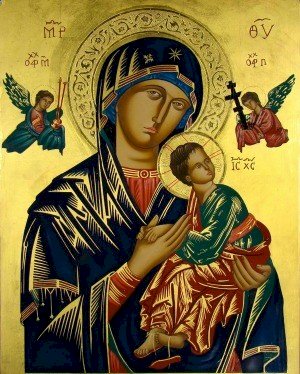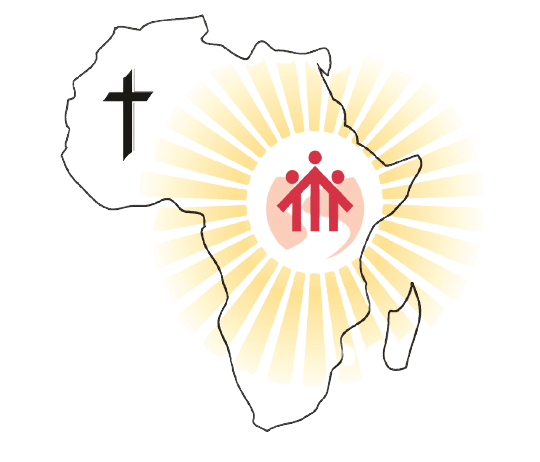The Icon of Our Lady of Perpetual Succour
Discover the messages contained in this amazing icon.

The Icon of Our Lady of Perpetual Succour
Our Lady never fails those who turn to her in need. And especially relevant in our needs is “Our Lady of Perpetual Help” or “Our Lady of Perpetual Succour.”
Let me share with you a little bit more about this amazing icon. Firstly, what is an icon?
An icon is not simply an artistic representation. Once it is blessed, it becomes a window to heaven, a point of contact, “so that in praying before it, one is in the spiritual presence of the person represented. Reverently kissing the icon, one kisses the personage; bowing before it, one bows before the personage.” (Robert Lane, “Russia and the Icon,” The Reign of Mary #117, p. 5)
This particular icon is painted on wood, and seems to date back to the thirteenth century, and is about 54 x 41.5 centimetres in size. It depicts Our Blessed Lady, under the title “Mother of God,” holding the Child Jesus. According to popular legend, a merchant acquired the icon of Our Lady of Perpetual Help from the island of Crete and had it shipped to Rome towards the end of the fifteenth century. During the voyage, a terrible storm arose, threatening the lives of all on board. The passengers and crew prayed to our Blessed Mother, and were saved.
Once in Rome, the merchant, dying, requested that the image should be displayed for public veneration. His friend, who was in possession of the image, received further instructions: in a dream to his little daughter, the Blessed Mother appeared and expressed the desire that the image be venerated in a Church between the Basilicas of St. Mary Major and St. John Lateran in Rome. The image was then housed at the Church of St. Matthew, and became known as “The Madonna of Saint Matthew.” For the following three centuries pilgrims flocked to the church, and great graces were bestowed upon the faithful. After Napoleon’s troops destroyed the Church of St. Matthew in 1812, the image was transferred to the Church of St. Mary in Posterula, and remained there for nearly forty years. There, the holy picture was neglected and forgotten.
By Divine Providence, the forgotten icon was rediscovered. In 1866, Blessed Pope Pius IX entrusted the image to the Redemptorists, who had just built the Church of St. Alphonsus, close to St. Mary Major. As a boy, the Holy Father had prayed before the image in the Church of St. Matthew. He ordered the public display and veneration of the blessed picture, and fixed the feast of Our Lady of Perpetual Help on the Sunday before the Feast of the Nativity of St. John the Baptist. In 1867, when the image was being carried in a solemn procession through the streets, a young child was cured, the first of many recorded miracles attributed to Our Lady of Perpetual Help.
Have a closer look at the image and you will observe the following:
The star in the centre of Mary's Veil is symbolic of her as the "Star of the Sea" who bore the light of Christ into our darkened world. This star leads us to the safe port of Heaven. The primary initials on either side of Our Lady's Crown are the Greek initials for "Mother of God. "The initials above the angel on the left are the Greek initials of St. Michael the Archangel. The angel on the left, St. Michael, is depicted holding the lance and gall-sop, foreshadowing Christ's Passion and death. Mary's red tunic is the colour worn by Virgins during the time of Jesus. Our Lady's Blue Garment is the colour worn by mothers in Palestine, symbolising that Mary is both Virgin and Mother. Both Mary and Jesus' clothing are colours of royalty. Our Lady's face is peaceful, serene, and contemplative of her Son Jesus' future sufferings. Our Lady's mouth is small and silent in prayer, meditation and recollection. Mary's eyes are large to see our troubles and needs; they are always turned toward us. They also tenderly plead for us to avoid sin and remain faithful to and love her Son, Jesus. The entire golden background is a symbol of Heaven, where both Jesus and Mary are now enthroned; this Light of Heaven radiates through both of their clothing: an indication of the heavenly joy they bring to human hearts. The initials above the angel on the right are the Greek initials of St. Gabriel the Archangel. The angel on the right, St. Gabriel, holds the cross and the nails, foreshadows of His Passion and death. The hands of the angels are covered in a veil much like that which the priest holds while blessing with the Blessed Sacrament in the monstrance during Benediction. The initials to the right of Jesus' head are the Greek initials for "Jesus Christ." The Child Jesus is depicted not as an infant, but as a "miniature adult," signifying Christ's Divinity and His Humanity. Mary's hands hold the Child Jesus possessively and lovingly, because she is His Mother. She is our loving Mother too. Her hand does not clutch the hands of Jesus' tightly, but remains open, inviting us to her Son, Jesus. The hands of Jesus are turned downward, a symbol of His placing the Graces of Redemption in her hands. These Graces are available to all and any who implore her for them through prayer. Jesus' sandal falling from His foot is indicative of the haste with which He has run to her in fear, gazing at the angels who hold the instruments of His Passion and death. The loose sandal also represents Christ's Divine Nature, untied from the bounds of earth. The sandal that remains secure is symbolic of His Human Nature.
So, what more encouragement do we need to pray to Our Lady of Perpetual Help? Many, many miracles have been wrought through devotion to her under this title. She cannot and will not refuse to help us in our needs. Let us then implore her to assist us in these very difficult times we are experiencing and let this holy image also be a reminder that we too can flee to her in our sufferings – just as Our Saviour Himself did.


















